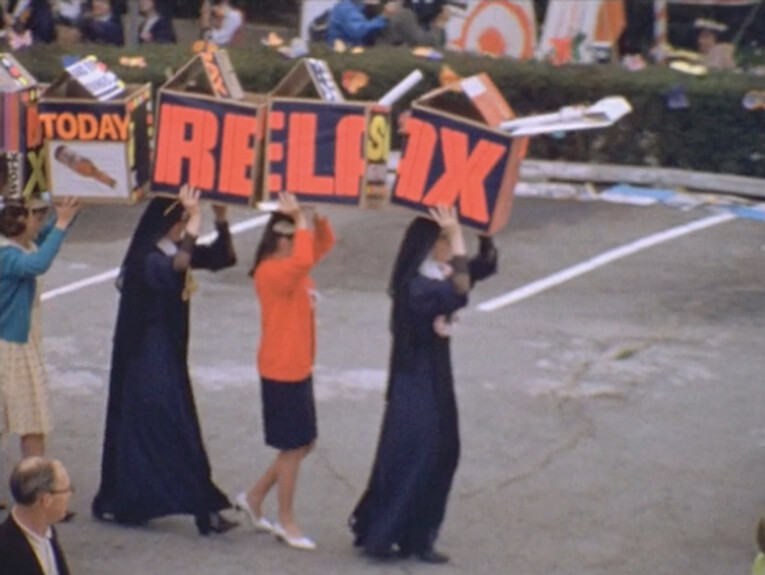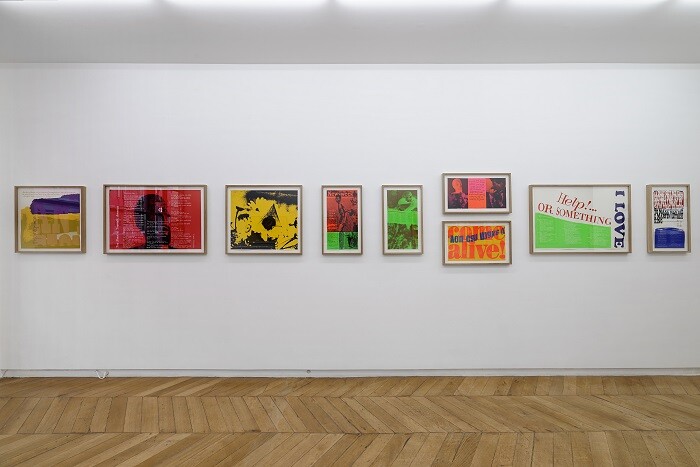In difficult times, we look to the past for comfort and clarity. In the wake of France’s deadliest attacks since World War II, Corita Kent’s late 1960s and early 1970s silkscreens promoting pacifism and tolerance take on an unexpected urgency. Planned well before terrorists killed 130 Parisians, Galerie Allen’s exhibition devoted to the late American artist, activist, educator, and former Catholic nun,1 now feels eerily prescient.
Not far from Place de la République, where a shrine of flowers, candles, posters, and photos honors victims of the attacks, the gallery’s street-facing window offers a taste of Kent’s Pop aesthetic and pacifist ethos. Painted in bright pink block letters directly onto the glass, the proclamation “Hope arouses as nothing else can arouse a passion for the possible” is an excerpt from Kent’s 1969 print a passion for the possible. Showing her flair for mixing text and images from diverse—sometimes seemingly antithetical—sources, this black and yellow silkscreen pairs a quote from clergyman and peace activist William Sloane Coffin with a silhouetted photo of protesters making peace signs with their raised hands.
In other broadsheet-sized prints on view, Kent cleverly commingles references from the Catholic Church, advertisements, newspaper headlines, and pop music to create political messages that are accessible and inspiring. But while her rhetoric might ring true today, her aesthetic is rooted in another place and time. Taking visual cues from psychedelic concert flyers, California surf culture, and contemporary artists like Andy Warhol and Robert Indiana, Kent’s late 1960s prints are characterized by DayGlo colors, collaged news photos, and a pre-punk mix of stenciled and handwritten text.
In a pair of related works, Moonflowers and Manflowers (both 1969), Kent uses two different high contrast yellow and purple images to illustrate the same text: the slogan “MAN POWER!” and the title lyric of Pete Seeger’s pacifist anthem, “Where have all the flowers gone?” With its cropped photo of the moon’s cratered surface, Moonflowers evokes the Space Race and Cold War anxiety. Meanwhile, an image of injured US soldiers in Vietnam makes Manflowers one of Kent’s most poignant antiwar posters. In different ways, both works undermine typically positive connotations of manpower, reminding us that man’s power is destructive as much as constructive.
One of several prints from Kent’s 1969 “Heroes and Sheroes” series, phil and dan pairs a blood red image of two priests standing above a bonfire with two handwritten quotations. One of the quotes is attributed to William Kunstler, the civil rights lawyer known for defending radical groups including the Black Panthers and the Weather Underground: “They were trying to make an outcry, an anguished outcry to reach the American community before it was too late. I think this is an element of free speech to try—when all else fails—to reach the community.” Kunstler also represented Philip and Daniel Berrigan (the two men pictured) as part of the so-called “Catsonville Nine” group of Catholic political activists convicted in 1968 for burning draft records with napalm. Kent’s most iconic heroes are even more tragic—among them President John F. Kennedy, Senator Robert F. Kennedy, and Dr. Martin Luther King Jr. Memorialized in magenta and green in Love your brother, King appears in two photographs: with his wife on the day he was awarded the Nobel Peace Prize and in a police car, under arrest. Across these paradoxical portraits Kent has written, “The king is dead. Love your brother.”
Two rarely seen, recently digitized 16mm films shown at opposite ends of the gallery further elucidate Kent’s spiritual, educational, and artistic philosophies. Shown on a plasma screen, Baylis Glascock’s two-channel Mary’s Day 1965 (1965) features documentary footage of nuns and students at Los Angeles’s Immaculate Heart College celebrating Mary’s Day. Under Kent’s artistic direction (she became chair of the school’s art department in 1964) an austere march commemorating the Assumption became a vibrant rally for peace and an end to world hunger. Women wearing colorful shift dresses, cat eye glasses, and flower wreaths proceed with handmade posters and floats while Kent provides a non-diegetic voiceover. Beginning with a quote by Friedrich Nietzsche, her monologue—more philosophical than religious—emphasizes community activism.
In Thomas Conrad’s documentary film Alleluia (1967), shown on a monitor on the floor, Kent speaks in front of the camera. Filmed in her nun’s habit in the Immaculate Heart College print shop, she discusses printmaking processes and what makes an effective artwork. During her 30-year tenure at Immaculate Heart, Kent designed a remarkably hip curriculum that included lectures by John Cage, Charles and Ray Eames, and Buckminster Fuller. One year after appearing in Conrad’s film, however, she left the college. In 1969, she was formally released from the order. Made just before and after this pivotal moment when Kent’s political activism and artistic license took precedence over her religious affiliation, the silkscreens presented at Galerie Allen reflect an internal struggle as well as a quest to make the world a better place.
The artist was better known as Sister Corita until she left the order of the Sisters of the Immaculate Heart of Mary in Los Angeles.












